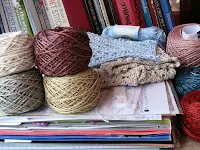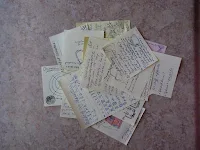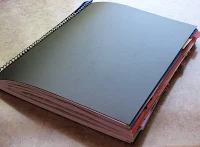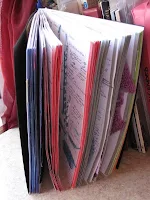
Can you find my notebook in this project pile?
We crocheters are a creative bunch. With all the fresh yarn colors, new crochet hooks, free crochet patterns, and exciting crochet fashions on the runways, some days my problem is too much inspiration! A crochet notebook really helps.
Do you already record your crochet inspirations somehow? If so, you know that there's more than one way to go about it.
I used to use sticky notes of all sizes and then throw them into folders.

I liked this because each design idea remained independent and
recombinable; they were also easy to jot down anywhere at any moment. I still have sticky note pads in every purse, car, and throughout the house so that no inspiration is ever forgotten.
The sticky note system is not ideal. I didn't like it because the ideas were less likely to evolve. They tended to remain just sparks, or seeds still needing to be planted. (Of concern to professional designers: no built-in intellectual property protection!)

Here's my basic system:
- I number each page consecutively in ink.
- I reserve the 2 back pages for indexing by page number.
- Each entry is in ink, dated, and initialed by me.
- If I had to jot down something on a sticky note or scrap paper, it gets firmly taped into the notebook as a signed and dated entry.
- No pages are ever ripped out.
I know what you're thinking: seems a bit formal. Hold that thought.
Other things that go into this notebook:
- sketches, diagrams
- inspiring clippings
- samples of crochet stitches and patterns
Not all of my swatching fits into a bound book like this but it's the ideal place to keep my thread crochet lace pieces. For sketches I've learned to keep colored pens nearby. Some ideas are just plain better drawn than written. Years later I especially enjoy looking at my quick sketches, even those that didn't seem like much at the time.

At first this was a big change and did seem a bit formal to me, but it's an easy habit and well worth it. It's a fertile garden where I can watch the seeds that I've planted grow over time. The entry dating turns it into a lovely memory book. I love just paging through this notebook. A big bonus is that all of these steps help to protect my ideas as the intellectual property that they are.
Sometimes while crocheting I jot down into this notebook seemingly random thoughts or opinions I have that are in any way related to crochet--maybe about the yarn or hook or pattern or color I'm using. Later, these thoughts become useful.
It's good for crocheters to recognize that what we naturally do generates intellectual property! Below are some links to descriptions of how design notebooks are used in other fields. I hope you are inspired to record your crochet stitches, experiments, observations, and daydreams.
































